Custom Design
Brand consistency is not simply about having the same logo everywhere. When your customers see various iterations of your brand across many touchpoints – from your website to your social media, from your email campaigns to customer service interactions – they start doubting your reliability and professionalism.
Consider the last time you’ve dealt with a brand that seemed disorganized. Perhaps their website was sleek and professional-looking, but their social media was clunky. Perhaps their email newsletters had varying fonts and colors from their website. What did that do to your perception of their credibility?
This lack of consistency between brand touchpoints confuses, undermines trust, and ultimately scares off potential customers. Without brand consistency, you’re pretty much inviting your audience to put the pieces together to figure out who you are through fractured experiences.
We’re going to take you by the hand through all there is to know about creating and sustaining brand consistency that not only appears professional but also establishes enduring trust with your audience. You’ll gain the strategic foundation that turns consistency from a design afterthought into competitive infrastructure, learn practical implementation frameworks across all of your brand touchpoints, and master the measurement methods that make your consistency efforts deliver tangible business outcomes.

Brand consistency is having a consistent, recognizable identity at every point of interaction between your brand and your audience. Brand consistency is the discipline of using the same visual elements, messaging tone, values, and customer experience no matter where or how anyone is reaching your brand.
But this is what most companies get wrong: brand consistency extends well beyond the replication of colours and fonts. It’s about delivering a cohesive experience that reinforces your brand personality, values, and promise across every interaction. When a visitor comes to your website having seen your Instagram post, they should instinctively know they are engaging with the same brand – not simply visually, but also emotionally.
The commercial effect of being consistent in branding is staggering. Science indicates that consistent presentation of brand can boost revenues by as much as 23%. When people know what to expect of your brand, they are more likely to trust you, recommend you, and select you over others.
Brand consistency succeeds because it minimizes cognitive load for your audience. Rather than having to reverse-engineer who you are and what you believe every time they interact with you, they can expend energy determining whether your product or service will fix their problem. This mental economy generates trust and speeds up decision-making.
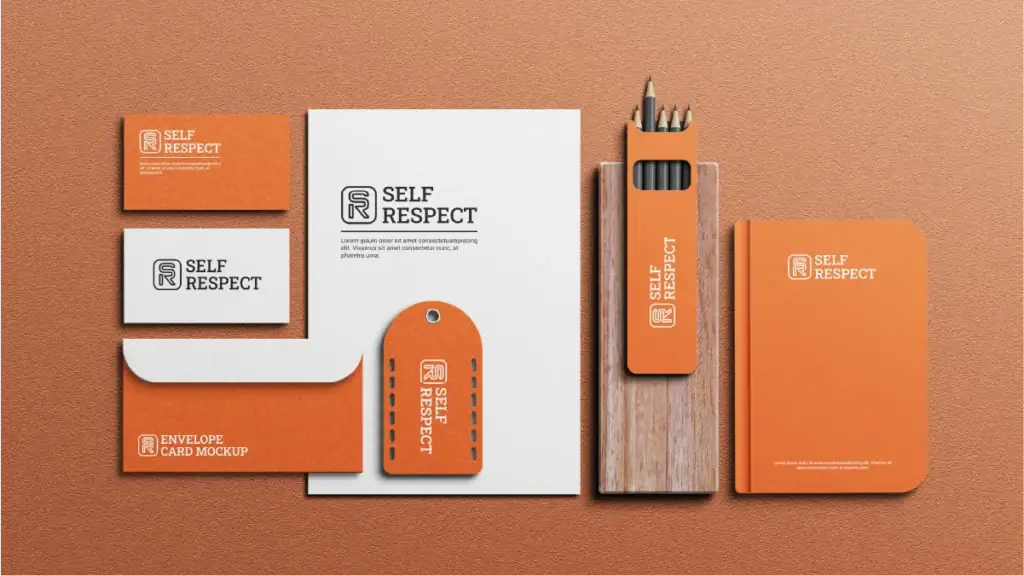
The strategic value of brand consistency goes far beyond looks. When you adhere to brand consistency, you’re creating competitive infrastructure that snowballs over time that gives you durable advantage that competitors can’t easily match.
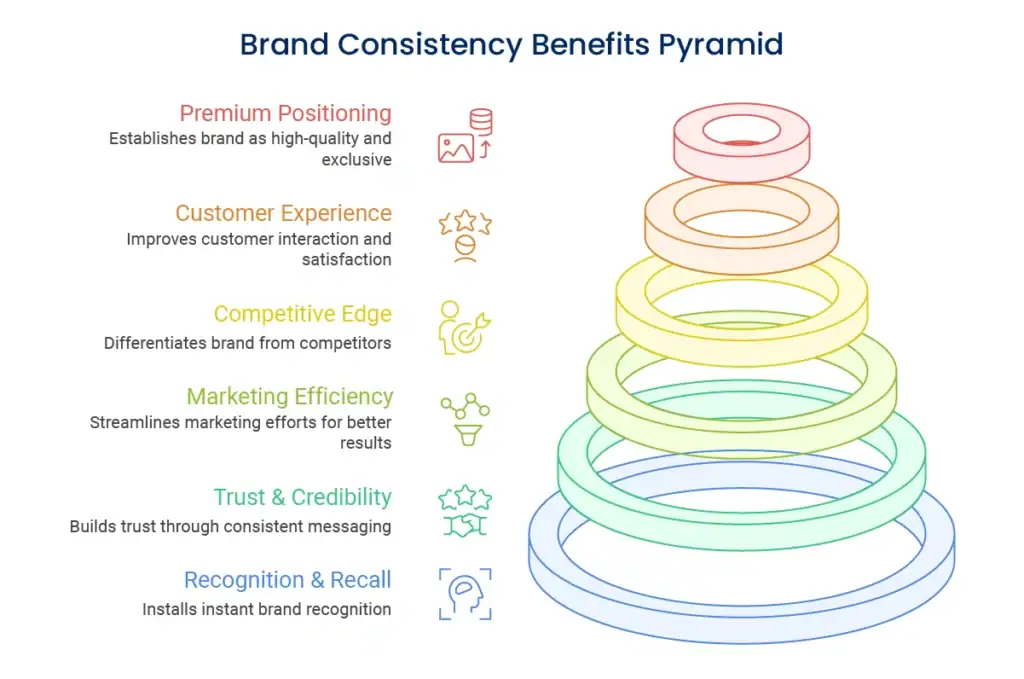
Uniform brands become instantly recognizable, even in a glance. If your visual elements, tone, and messaging are always consistent across touchpoints, you habituate your audience to recognize you at once. Recognition is what translates into mental availability – when customers need what you have, your brand pops up first.
Consistency conveys professionalism and detail orientation. When all parts of your brand seem thoughtful and integrated, customers project the same level of care onto your products or services. This felt reliability is the basis for creating brand trust that fosters long-term customer relationships.
Brands with a consistent message need fewer repetitions to be effective. When your visual identity and messaging don't change, every time people see you, they're reinforcing previous impressions, so your marketing budget gets more bang for the buck. You'll waste less time reintroducing yourself and spend more time communicating value.
Most companies battle with consistency, particularly smaller enterprises handling multiple channels with limited budgets. By being consistent in your branding, you automatically outshine more amateurish, less established competitors who project disjointed identities.
Consistency creates predictability, and predictability creates comfort. When customers know what to expect from each interaction with your brand, they feel more confident engaging with you. This comfort leads to higher conversion rates and increased customer lifetime value.
Consistent brands can sell at a premium because consistency commands quality and trust. With each touchpoint supporting your brand's value proposition, consumers become willing to pay a premium for the confidence that they get with a professional, consistent experience.
Developing consistent sustainability of the brand needs a systematic framework that exceeds surface-level design choices. Your brand structure is the strategic foundation, which directs each decision regarding consistency and ensures cohesive execution throughout all touchpoints.

Your framework for consistency must act as competitive infrastructure – a structured system that produces lasting differentiators and minimizes operating complexity. This platform is your foundation of core brand elements that don’t change while providing flexibility in usage.
Begin by establishing your brand’s immovable pieces: your mission, values, and unique value proposition. These create the philosophical foundation that informs every consistency decision. When employees grasp why certain things don’t change, they make more effective decisions about when and how to vary your brand for varying situations.
Your visual identity system should have consistent hierarchy and relationships among elements. Core elements such as your logo, color palette, and typography must have strict usage restrictions, while secondary elements may provide controlled flexibility across various uses or audiences.
Comprehensive brand guidelines serve as your consistency blueprint, but they must be practical tools rather than restrictive rulebooks. Effective guidelines anticipate real-world application challenges and provide clear solutions for common scenarios.
Document your visual standards with specific measurements, colour codes, and spacing requirements. Include examples of correct and incorrect usage to prevent common mistakes. But go beyond visuals – document your brand voice, messaging frameworks, and customer experience standards.
Develop role-based guidelines for various team members. Your sales team requires different guidelines than your social media manager. Develop your documentation to speak to the unique consistency issues every role has while ensuring overall brand consistency.
Your brand voice and messaging architecture need the same structured methodology as visual elements. Establish definitive guidelines for tone, word choice, and communication style that do not change across channel or audience.
Develop messaging hierarchies that enable team members to prioritize information in a consistent manner. Your key value propositions should appear clearly and consistently, with supporting messages variable within specific contexts or audiences.
Implement content approval processes that keep consistency without hindering marketing execution. Well-defined guidelines minimize the requirement for lengthy reviews while ensuring all communications are consistent with your brand standards.
Your brand positioning has to be consistent even when you adjust your messaging for various audiences or channels. Create structures that grant tactical flexibility but keep strategic consistency intact.
Get it in writing and position yourself as compared to competitors and keep it the same across all communications. When all people have a clear idea of how your brand is positioned in the market environment, they are able to have consistent positioning even when adjusting messages for particular contexts.
Effective brand consistency involves systematic execution at all points of customer contact. Every touchpoint comes with specific limitations and opportunities, yet your strategy should provide consistent brand experience despite context and channel.
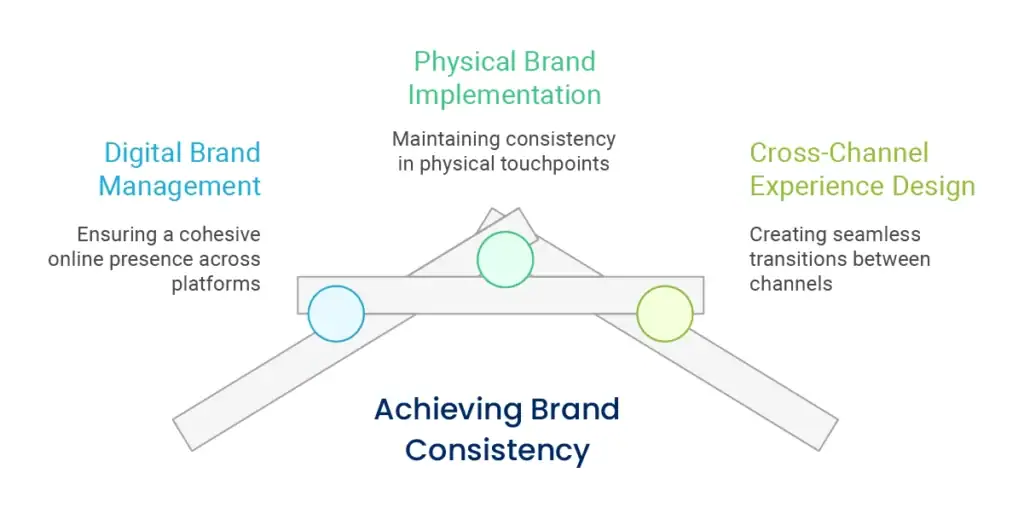
Your online presence provides maximum control over brand consistency, yet the most complexity. Website, social media, email marketing, and online advertising have to integrate to present a cohesive online brand experience.
Website consistency goes beyond visual design to encompass user experience patterns, content structure, and interaction design. Your navigation, page layouts, and user flows should match your brand personality yet meet usability standards.
Social media consistency involves striking a balance between platform-specific needs and brand expectations. Build up templates and content structures that scale across various platform dimensions and audiences without sacrificing recognizable brand elements.
Email marketing tends to be forgotten in consistency strategy, but it’s often your most immediate customer communication. Be sure your email templates, subject line treatment, and content tone are aligned to your overall brand voice and visual identity.
Physical touchpoints are different in consideration from digital ones, but consistency principles are the same. Office design, packaging, business cards, and even employee appearance add to brand consistency.
Consistency of packaging becomes especially important for product companies. Your packaging must immediately relate to your digital presence while fulfilling functional needs. Think about how your packaging looks in customer photos and social media shares.
Offices and retail spaces should project your brand identity through environmental design. Colour palettes, furniture selection, and even music cues can aid in brand consistency if managed methodically.
Brand consistency in reality demands thinking outside single touchpoints to craft unified cross-channel experiences. Customers typically do not engage with individual touchpoints independently – they shift between your site, social media, email, and brick-and-mortar stores anticipating fluid transitions.
Chart out customer journeys to find consistency touchpoints and transition points. Be particularly aware of times when customers shift from one channel to another, making sure that these transitions strengthen instead of undermining brand perception.
Create handoff procedures for customer interactions that span channels. When a social media query is transferred to email or phone service, the customer should perceive it as a continuation instead of beginning anew with a different brand.
Brand consistency is not simply about deployment – it needs systematic measurement and ongoing optimisation. Without measurement, consistency efforts turn into subjective practices instead of strategic business investments.

Periodic brand consistency audits detect gaps and opportunities and avoid consistency drift over time. A systematic audit process checks each customer touchpoint against set brand standards.
Create audit checklists that address visual consistency, message alignment, and experience harmony. Both quantitative metrics (colour accuracy, use of font) and qualitative evaluations (tone consistency, experience quality) should be included.
Conduct audits on a quarterly basis to capture problems prior to their affecting customer perception. More regular audits might be required when there is dramatic growth or high levels of marketing activity.
Monitor consistency with both direct and indirect measures. Direct measures are brand recall rates, visual consistency ratings, and message alignment tests. Indirect measures are customer satisfaction scores, brand trust scales, and marketing effectiveness metrics.
Monitor customer comments for consistency-related statements. Customers usually observe and remark on consistency problems before in-house teams detect them. Social media posts, customer service comments, and survey answers offer great consistency intelligence.
Track the business value of consistency initiatives by using conversion rates, customer lifetime value, and ROI for marketing. These serve to illustrate the business value of consistency investment and shape future efforts at improvement.
Today’s brand consistency demands technology that facilitates and does not hinder implementation. Select tools that assist team members in consistency while allowing streamlined content creation and delivery.
Digital asset management software ensures all users work with up-to-date, approved brand assets. These tools avoid the use of old logos or incorrect colour schemes and make approved materials easily accessible.
Brand management platforms may automate consistency checks and offer instant feedback on brand compliance. Such tools minimize manual supervision required without compromising on consistency levels.
Content management systems would need to have brand compliance features that assist content producers in keeping things consistent automatically. Templates, style guides, and approval workflows incorporate consistency into content creation processes.
Consistency becomes even more important during tough times. Times of crisis put your brand to the test and show whether your consistency-building efforts result in real strength or just surface-level consistency.

Crisis times tend to put pressure on companies to drop consistency for swift response. But consistency in your brand during tough times actually builds trust and confidence among customers and your stability.
Create crisis communication templates that continue to represent your brand voice while dealing with crisis situations. These templates ensure consistency when usual approval processes may not be possible.
Train employees to uphold brand standards under pressure. Once the reasons why consistency is crucial are clear to all, they’re less likely to sacrifice it even under pressure and tight deadlines.
When reputation challenges arise, consistent brand behaviour helps rebuild trust more effectively than scattered recovery efforts. Customers judge your response consistency as much as your actual solutions.
Document your approach to handling negative feedback or public relations challenges. Consistent response strategies demonstrate professionalism and help prevent individual incidents from becoming larger reputation issues.
As your organisation increases and develops, your strategy for brand consistency needs to get more advanced but still be pragmatic enough for everyday implementation. Sophisticated strategies enable you to stay consistent at scale while responding to new challenges and opportunities.
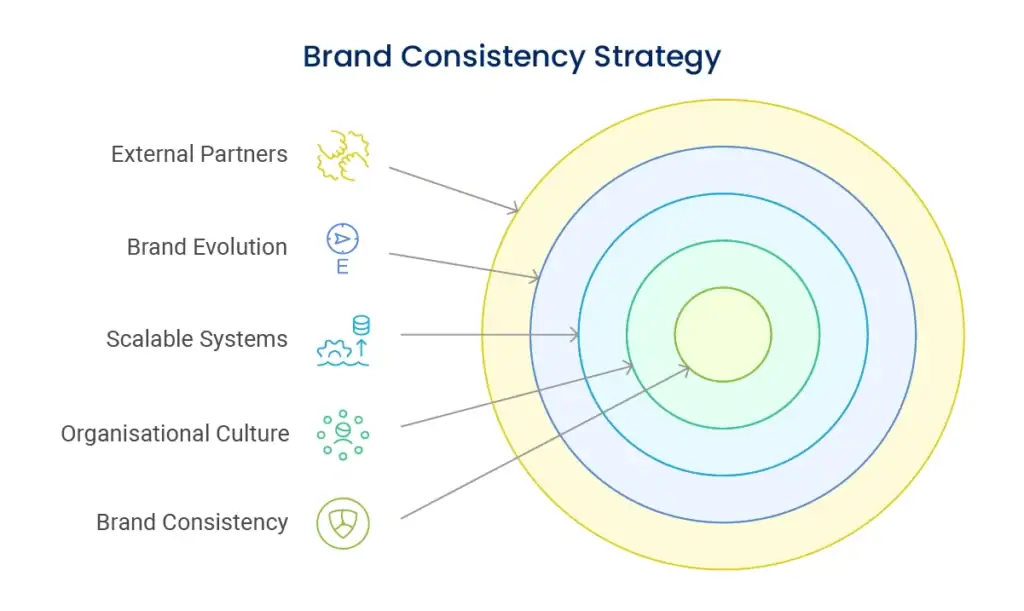
Authentic brand consistency demands cultural integration across your business. When brand values and standards are part of the company culture, consistency is a byproduct of happening naturally instead of through enforcement and monitoring.
Embed brand training into employee onboarding. New hires not only need to know what your brand looks like, but why consistency is important and how their own work adds up to overall brand experience.
Create brand champions in various departments who can give advice and enforce standards without introducing bureaucratic hurdles. Internal champions resolve consistency issues while increasing overall awareness of brand significance.
Scaling businesses require consistency systems that scale well without proportionate increases in management and control. Construct processes that sustain standards and allow growth and expansion.
Construct approval workflows that sustain quality without hindering execution. Decision frameworks and guidelines facilitate team members to make good consistency decisions on their own, bypassing bottlenecks without losing standards.
Create vendor and partner guidelines that extend your brand consistency to external team members. External partners have a big role in how your brand is perceived, so they must have clear guidance on upholding your standards.
Brands need to evolve to stay relevant, but evolution needs to be handled with care to not lose consistency advantages. Create frameworks for brand evolution that balance recognition with the adaptation needed.
Make brand updates in an orderly fashion instead of making piecemeal changes that introduce inconsistency. When visual updates are necessary, introduce them to all touchpoints at the same time to preserve consistent brand experience.
Document the “why” behind brand changes so team members can grasp and consistently apply updates. If team members know why changes are being introduced, they can execute them more successfully.
Consistency generates compounding benefits that multiply over time. Knowing how these long-term value creation factors work enables you to make smarter consistency investments and quantify their real business effects.

Trust arises from repeated positive experiences that either meet or surpass expectations. Brand consistency ensures each experience helps build trust instead of causing confusion and disappointment.
Consistent brands deliver consistent experiences that customers know they can count on. That reliability becomes especially important as customers increasingly make more complex buying decisions and look for brands they trust.
Consistent brand experiences boost customer satisfaction and retention by eliminating friction and enhancing predictability. When customers expect what to happen when they interact with your brand, they’re more likely to come back and tell others about you.
Customer retention and loyalty programs function better when backed by brand consistency. Consistency ensures the value proposition that brought customers in the first place is upheld and sustains continuity of engagement in the long run.
Technology and market evolution will continue to generate new touchpoints and interaction opportunities. Your consistency platform should be forward-thinking and evolve with changes while upholding core brand identity.
Create principles-based guidelines that are able to evolve to new channels and technologies. If your consistency framework is based on underlying principles and not specific tactics, it continues to apply as new opportunities arise.
Future-proof for emerging communication channels and technologies by setting how your brand will tackle new opportunities. Consistent principles enable you to analyze new channels and integrate them in a manner that reinforces instead of fractures your brand identity.
Enforcing efficient brand consistency demands systematic implementation balanced between thoroughness and realistic business necessities. This incremental strategy allows you to develop sustainable consistency without overburdening your staff or altering existing operations.
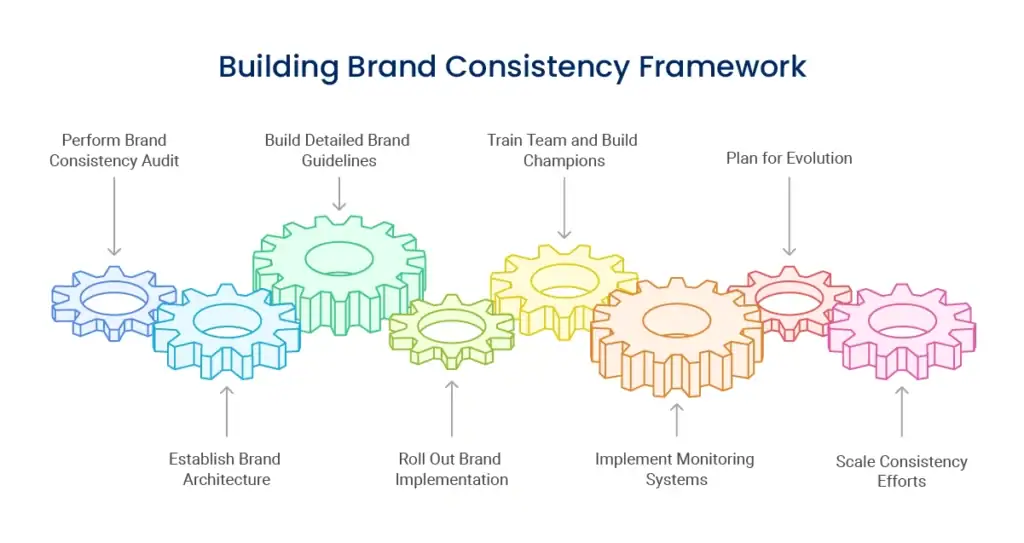
Start by assessing your existing brand implementation in all touch points. Record all areas your brand exists – website, social media pages, email signatures, business cards, packaging, signs, and other customer touch points.
Capture screenshots and gather samples of each brand execution. Make a spreadsheet that catalogs each touch point with comments regarding differences or opportunities for improvement. Check for inconsistency in the use of logos, color applications, font use, message tone, and presentation quality overall.
Give attention to customer-facing touchpoints that truly have the biggest impact on brand perception. Don’t forget to prioritize your website homepage, principal social media profiles, and most frequent types of customer communications in your consistency efforts.
Determine those elements that are truly non-negotiable and will serve to anchor your framework for consistency. Then start with the mission, vision, and core values – truly the philosophical foundation upon which all other consistency decisions are built.
Document your visual identity system with precise specifications. Define exact color codes (RGB, CMYK, and hex values), font specifications with sizing and spacing information, logo usage guidelines with minimum size dimensions and clear space definitions, and any other visual elements that determine your brand look.
Build your messaging structure by establishing your brand voice, tone, and essential messages. Add vocabulary guidelines, communication style preferences, and examples of proper and improper messaging styles.
Turn your brand architecture into usable guidelines that team members can indeed employ. Produce documentation that deals with realistic usage scenarios instead of hypothetical standards.
Organize your guidelines by audience and use case. Offer quick-reference sections for popular use cases such as social media tweets, email signatures, or presentation templates. Use examples of the correct and incorrect implementation to avoid common errors. Make it easy to access and search your guidelines. Think about making digital guidelines easily updatable and available for team members when they need them. Offer contact details for questions related to the brand as well as decision-making rights.
Roll out your system of consistency systematically, beginning with the highest-impact touchpoints. Start with your website and major social media accounts, then work outward to additional digital touchpoints before getting to physical materials.
Design templates and assets that simplify consistency. Create social media templates, email signatures, presentation templates, and other frequently used materials that include your brand standards automatically.
Implement approval mechanisms that ensure quality without putting bottlenecks in the way. Define clearly what materials need to be reviewed and approved against what can be produced by team members independently based on approved templates and guidelines.
Educate your staff on the significance of brand consistency and their part in upholding standards. Do not just demonstrate to them what your brand looks like – make them comprehend why consistency is crucial and how their choices affect overall brand perception.
Discover brand champions across various departments who can support them with advice and uphold standards. They are your consistency supporters who assist in resolving problems and responding to questions without causing further management overhead.
Create role-specific training that confronts the consistency issues every member of each team is dealing with. Your social media manager requires different advice than your sales team, but both need to comprehend the overall framework for consistency.
Establish monitoring and measurement systems for consistent monitoring that catch problems before they affect customer perception. Establish regular review processes that analyze brand implementation at all touchpoints.
Create metrics that measure both business impact and compliance. Follow brand awareness, customer satisfaction, and marketing effectiveness in addition to direct consistency metrics such as visual compliance and message alignment.
Utilize technology tools that facilitate automatic consistency checking where possible. Digital asset management systems, brand compliance software, and content management tools can minimize hands-on oversight while ensuring high standards.
Create flexibility in your consistency system that supports brand development without losing coherence. Create procedures for revising brand standards that keep things consistent while facilitating change. Plan periodic brand consistency checks that assess both existing implementation and future requirements. Changes in the market, growth in the business, and emerging technology opportunities might necessitate revision of your consistency method.
Document lessons learned and continually refine your processes for consistency. As your team becomes more seasoned at sustaining consistency, seek opportunities to streamline processes while enhancing performance.
As your business scales, extend your consistency framework to cover new touchpoints and employees. Develop systems to sustain standards without necessitating proportional increases in management oversight.
Establish partner and vendor guidelines that expand your consistency effort beyond internal team members. External collaborators can have a strong influence on brand perception, so they must have clear guidance on upholding your standards.
Establish succession planning for brand consistency knowledge and duties. Have several team members know your consistency framework so that changes in personnel do not interfere with brand implementation.
Recognizing common consistency traps ensures that you avoid issues before they affect your brand image. Such errors are prevalent in companies of all sizes, but it is relatively easy to avoid them with proper planning and knowledge.
Only too many companies focus on visual consistency while excluding messaging, customer experience, and cultural fit. Real consistency cuts across each contact area of your brand.
Solution: Create consistency frameworks that handle visual, verbal, and experiential aspects on an equal basis. Educate team members to think about consistency effects across a wider range of than just design choices.
Too restrictive guidelines can hinder effective communication and restrict opportunities for growth. Your consistency framework must offer clear guidance but make room for essential adaptability.
Solution: Target your strongest requirements on fundamental brand components with flexibility frameworks for adaptation. Clarify to team members when adaptation is in order and when consistency is absolutely necessary.
Providing brand guides without proper training tends to create inconsistent application. Team members must know both the what and why of brand consistency.
Solution: Invest in in-depth brand training on principles, as well as strategies. Training updates on a regular basis ensure consistency knowledge is sustained as your team expands and changes.
Initial implementation of consistency usually declines without periodic monitoring and upkeep. Consistency demands constant care instead of initial setup.
Solution: Institute periodic monitoring procedures and delegate responsibility for consistency to certain team members. Implement systems that detect and solve consistency problems before they become major issues.
Brand consistency creates both immediate and long-term benefits, but the timeline varies depending on your starting point and implementation scope. Visual consistency improvements often show immediate results in customer perception and marketing effectiveness.
Recognition and trust benefits usually materialize between 3-6 months of continuous application. You will observe better customer feedback, boosted engagement rates, and better conversion rates as your public becomes accustomed to your continuous brand presentation.
Long-term advantages such as higher customer loyalty, premium pricing capability, and higher marketing efficiency take hold over 12-18 months. These compounding benefits are the best business return on consistency investments.
Brand consistency investments are proportional to business size and sophistication. Small businesses can see major consistency improvement through modest investment with high-priority touchpoints and smart implementation.
Budget ₹50,000 to ₹2,00,000 for developing initial consistency frameworks, including creation of guidelines, development of templates, and basic training. This investment will usually return itself through enhanced marketing efficiency and customer conversion rates.
Continuity maintenance needs around 5-10% of your marketing budget, which is mainly used for monitoring, updates, and training. By spending money on these, consistency does not deteriorate and compound benefits keep building up over time.
Effectively designed brand consistency models facilitate instead of constrain creativity by creating well-defined constraints within which creative solutions can thrive. The secret is to define what needs to stay constant and where creative adjustment is beneficial.
Direct rigid consistency at essential brand elements such as values, main visual identity, and essential messaging. Grant creative freedom in campaign execution, content development, and channel-specific adaptations that preserve overall brand coherence.
Creative teams actually do better with tight constraints since they are able to direct creative energy towards resolving particular problems instead of creating every element from the ground up. Consistency frameworks give direction for creativity instead of creative restraint.
International brand consistency demands striking a balance between global brand elements and local market modifications. Create models that determine what stays same across the globe and what can vary with local tastes and cultural needs.
Core brand values, visual identity components, and core positioning must stay the same in markets. Local modifications may involve language translation, cultural colour sensitivity, and market-specific communication strategies that keep overall brand consistency.
Partner with local digital marketing agencies familiar with both your brand guidelines and local market conditions. Give them clear instructions and approval cycles that ensure consistency without hindering effective local market interaction.
Brand consistency evolves from functional necessity to competitive strength when used systematically and enforced uniformly. The companies that excel at consistency deliver customer experiences that establish trust, foster loyalty, and command premium positioning within their markets.
Your consistency efforts build upon one another over time and create sustainable advantages that are harder and harder for competitors to copy. Each consistent interaction builds recognition, trust, and preference that is fueled by future marketing efforts and business growth.
The model we’ve discussed gives you the foundation to construct consistency that functions in your unique business environment and growth phase. Begin with your highest-leverage touchpoints, create systems that grow with your company, and have the discipline to track and refine your consistency over time.
Keep in mind that consistency of brand is not perfection – it’s systemic, deliberate alignment that benefits your customers and underpins your business goals. When you’re committed to consistency as competitive infrastructure instead of creative constraint, you create advantages that snowball into substantial business value.
Your brand consistency efforts will be tested and need constant focus, but the companies that continue to adhere to high consistency standards develop lasting competitive positions that fuel sustainable growth and customer loyalty.
Establishing and sustaining brand consistency involves expertise, time, and disciplined implementation that few businesses can coordinate with their central activities. If you’re willing to advance your brand consistency from disjointed activities to competitive edge, think about hiring experienced experts who know both the strategic value and practical hurdles of implementation.
Our brand strategy team assists organizations such as yours in creating and executing consistency frameworks that generate quantifiable business outcomes while being reasonable for everyday use. We are able to assist you in auditing your existing consistency, creating thorough guidelines, and establishing systems that uphold standards as your business expands.
Prioritize talent building, service delivery excellence, and client relationship management in your strategic roadmap. Think about how you’ll scale expertise and preserve service quality as your business scales.
Share resources, capabilities, and learnings across markets. This could involve global technology platforms, common service centres, or cross-market talent development initiatives.

Enter your email to get instant access